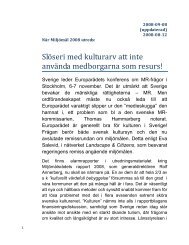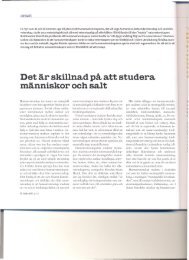Landscape through literature Le paysage à travers la littérature
Landscape through literature Le paysage à travers la littérature
Landscape through literature Le paysage à travers la littérature
Create successful ePaper yourself
Turn your PDF publications into a flip-book with our unique Google optimized e-Paper software.
44<br />
I T A L Y / I T A L I E<br />
Alessandro MANZONI (1785-1873)<br />
I promessi sposi<br />
Quel ramo del <strong>la</strong>go di Como, che volge a mezzogiorno,<br />
tra due catene non interrotte di monti, tutto a<br />
seni e a golfi, a seconda dello sporgere e del rientrare<br />
di quelli, vien, quasi a un tratto, a ristringersi, e a<br />
prender corso e figura di fiume, tra un promontorio a<br />
destra, e un’ampia costiera dall’altra parte; e il ponte,<br />
che ivi congiunge le due rive, par che renda ancor più<br />
sensibile all’occhio questa trasformazione, e segni il<br />
punto in cui il <strong>la</strong>go cessa, e l’Adda rincomincia, per<br />
ripigliar poi nome di <strong>la</strong>go dove le rive, allontanandosi<br />
di nuovo, <strong>la</strong>scian l’acqua distendersi e rallentarsi in<br />
nuovi golfi e in nuovi seni.<br />
La costiera, formata dal deposito di tre grossi torrenti,<br />
scende appoggiata a due monti contigui, l’uno detto<br />
di san Martino, l’altro, con voce lombarda, il «Resegone»,<br />
dai molti suoi cocuzzoli in fi<strong>la</strong>, che in vero lo<br />
fanno somigliare a una sega: talché non è chi, al primo<br />
vederlo, purché sia di fronte, come per esempio di su<br />
le mura di Mi<strong>la</strong>no che guardano a settentrione, non lo<br />
discerna tosto, a un tal contrassegno, in quel<strong>la</strong> lunga<br />
e vasta giogaia, dagli altri monti di nome più oscuro<br />
e di forma più comune. Per un buon pezzo, <strong>la</strong> costa<br />
sale con un pendìo lento e continuo; poi si rompe in<br />
poggi e in valloncelli, in erte e in ispianate, secondo<br />
l’ossatura de’ due monti, e il <strong>la</strong>voro dell’acque. Il lembo<br />
estremo, tagliato dalle foci de’ torrenti, è quasi tutto<br />
ghiaia e ciottoloni; il resto, campi e vigne, sparse di<br />
terre, di ville, di casali; in qualche parte boschi, che si<br />
prolungano su per <strong>la</strong> montagna.<br />
n a t u r o p a n o 1 0 3 / 2 0 0 5<br />
The bethrothed<br />
That branch of the <strong>la</strong>ke of Como, which extends towards<br />
the south, is enclosed by two unbroken chains of mountains,<br />
which, as they advance and recede, diversify its<br />
shores with numerous bays and inlets. Suddenly the<br />
<strong>la</strong>ke contracts itself, and takes the course and form of<br />
a river, between a promontory on the right, and a wide<br />
open shore on the opposite side. The bridge which<br />
there joins the two banks seems to render this transformation<br />
more sensible to the eye, and marks the point<br />
where the <strong>la</strong>ke ends, and the Adda again begins –<br />
soon to resume the name of the <strong>la</strong>ke, where the banks<br />
receding afresh, allow the water to extend and spread<br />
itself in new gulfs and bays.<br />
The open country, bordering the <strong>la</strong>ke, formed of the alluvial<br />
deposits of three great torrents, reclines upon the<br />
roots of two contiguous mountains, one named San<br />
Martino, the other, in the Lombard dialect, Il Resegone,<br />
because of its many peaks seen in profile, which in<br />
truth resemble the teeth of a saw so much so, that no<br />
one at first sight, viewing it in front (as, for example,<br />
from the northern bastions of Mi<strong>la</strong>n), could fail to distinguish<br />
it by this simple description, from the other mountains<br />
of more obscure name and ordinary form in that<br />
long and vast chain. For a considerable distance the<br />
country rises with a gentle and continuous ascent; afterwards<br />
it is broken into hill and dale, terraces and<br />
elevated p<strong>la</strong>ins, formed by the intertwining of the roots<br />
of the two mountains, and the action of the waters. The<br />
shore itself, intersected by the torrents, consists for the<br />
most part of gravel and <strong>la</strong>rge flints; the rest of the p<strong>la</strong>in,<br />
of fields and vineyards, interspersed with towns, vil<strong>la</strong>ges,<br />
and hamlets: other parts are clothed with woods,<br />
extending far up the mountain.<br />
From The Harvard c<strong>la</strong>ssics, edited by Charles W. Eliot.<br />
New York: P.F. Collier & Son, 1909-14.<br />
<strong>Le</strong>s fiancés<br />
<strong>Le</strong> bras du <strong>la</strong>c de Côme qui se dirige vers le midi, entre<br />
deux chaînes non interrompues de montagnes, et coule<br />
tout entier, selon qu’elles s’en approchent ou qu’elles<br />
s’en écartent, en baies et en golfes, vient enfin <strong>à</strong> se<br />
resserrer tout <strong>à</strong> coup et <strong>à</strong> prendre le cours et l’apparence<br />
d’un fleuve entre un promontoire <strong>à</strong> droite et une<br />
<strong>la</strong>rge rivière de l’autre côté. <strong>Le</strong> pont qui joint en cet<br />
endroit les deux rives l’une <strong>à</strong> l’autre semble rendre ce<br />
brusque passage encore plus sensible <strong>à</strong> l’œil, il marque<br />
le point où le <strong>la</strong>c finit et l’Adda recommence, pour<br />
reprendre ensuite son nom de <strong>la</strong>c au lieu où les rives,<br />
en s’é<strong>la</strong>rgissant encore, permettent <strong>à</strong> l’eau de se<br />
déployer et de ralentir son cours en de nouveaux golfes<br />
et de nouvelles baies.<br />
La rivière, formée par <strong>la</strong> réunion de trois gros torrents,<br />
descend le long du penchant de deux monts contigus,<br />
dont l’un porte le nom de San-Martino, et l’autre, en<br />
dialecte lombard, celui de Resegone, <strong>à</strong> cause de ses<br />
nombreuses dentelures qui le font tellement ressembler<br />
<strong>à</strong> une scie, qu’au premier aspect et vu de face, par<br />
exemple de <strong>la</strong> partie des remparts de Mi<strong>la</strong>n qui regarde<br />
le nord, il n’est personne qui, <strong>à</strong> ce simple indice, ne le<br />
distingue parfaitement, dans ce long et vaste amas de<br />
cimes, des autres montagnes d’un nom plus obscur et<br />
d’une forme plus commune. Durant une bonne partie<br />
de son cours, <strong>la</strong> rivière coule dans un lit d’une pente<br />
douce et continue; puis interrompue dans sa marche<br />
par des coteaux et de petits vallons, elle se précipite<br />
en cascade ou s’étend en <strong>la</strong>rges f<strong>la</strong>ques, selon le plus<br />
ou moins d’obstacles qu’opposent les deux montagnes<br />
et le travail des eaux. La lisière, sillonnée par les bouches<br />
des torrents, n’est presque que du gravier et des cailloux;<br />
le reste du sol se compose de champs et de vignobles<br />
parsemés de vil<strong>la</strong>ges, de maisons de p<strong>la</strong>isance et de<br />
chaumières, de loin en loin ce sont des bois qui se<br />
prolongent jusque sur <strong>la</strong> montagne.<br />
Traduction: Rey Dusseuil.





